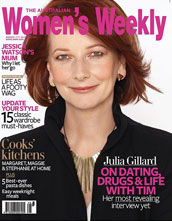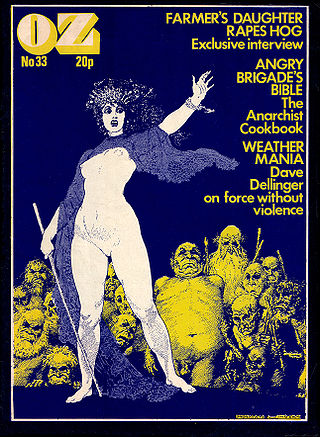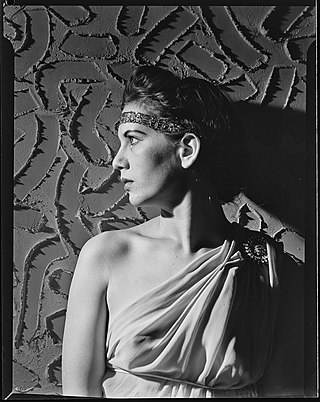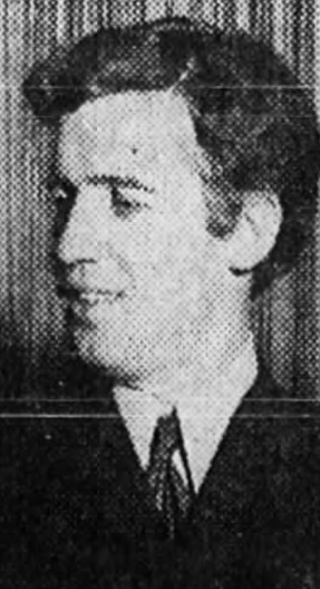Related Research Articles

The Australian Women's Weekly, sometimes known simply as The Weekly, is an Australian monthly women's magazine published by Are Media in Sydney and founded in 1933. For many years it was the number one magazine in Australia before being outsold by the Australian edition of Better Homes and Gardens in 2014. As of February 2019, The Weekly has overtaken Better Homes and Gardens again, coming out on top as Australia's most read magazine. The magazine invested in the 2020 film I Am Woman about Helen Reddy, singer and feminist icon.
Robert Alexander Hayes was an Australian Associate professor of Law at the University of Western Sydney.

Oz was an independently published, alternative/underground magazine associated with the international counterculture of the 1960s. While it was first published in Sydney in 1963, a parallel version of Oz was published in London from 1967. The Australian magazine was published until 1969 and the British version until 1973.

Barry Owen Jones,, is an Australian polymath, writer, teacher, lawyer, social activist, quiz champion and former politician. He campaigned against the death penalty throughout the 1960s, particularly against the execution of Ronald Ryan. He is on the National Trust's list of Australian Living Treasures.

Charmian Clift was an Australian writer. She was the second wife and literary collaborator of George Johnston.
Stuart Forbes Macintyre was an Australian historian, and Dean of the Faculty of Arts at the University of Melbourne from 1999 to 2008. He was voted one of Australia's most influential historians.
Angus & Robertson (A&R) is a major Australian bookseller, publisher and printer. As book publishers, A&R has contributed substantially to the promotion and development of Australian literature. The brand currently exists as an online shop owned by online bookseller Booktopia. The Angus & Robertson imprint is still seen in books published by HarperCollins, a News Corporation company.
Richard Clive Neville was an Australian writer and social commentator who came to fame as an editor of the counterculture magazine OZ in Australia and the United Kingdom in the 1960s and early 1970s. He was educated as a boarder at Knox Grammar School and enrolled for an arts degree at the University of New South Wales in Sydney, Australia. Australian political magazine The Monthly described Neville as a "pioneer of the war on deference".
Herbert Feith was an Australian academic and world leading scholar of Indonesian politics.

Nadia Wheatley is an Australian writer whose work includes picture books, novels, biography and history. Perhaps best known for her classic picture book My Place, the author's biography of Charmian Clift was described by critic Peter Craven as 'one of the greatest Australian biographies'. Another book by Wheatley is A Banner Bold, a historical novel.
Jim Falk is a physicist and academic researcher on science and technology studies.
POL was a monthly magazine that was first published by Gareth Powell Publishing in Australia in the late 1960s. It is considered to have played an important role in raising awareness of the status of women, and established new standards in terms of content, design and photography.
Peter John Rose is an Australian poet, memoirist, critic, novelist and editor. For many years he was an academic publisher. Since 2001 he has been editor of Australian Book Review.
Peter Beilharz is an Australian sociologist. He is professor of critical theory at Sichuan University, Chengdu, PRC. Previously he was professor of sociology and remains Emeritus Professor at La Trobe University, Melbourne. He is adjunct professor at Curtin University, Perth, Western Australia. Beilharz is founding editor of the international journal of social theory Thesis Eleven published by Sage.
Maxwell MacAlister Brown was an Australian novelist and journalist.
Joan Errington Beaumont, is an Australian historian and academic, who specialises in foreign policy and the Australian experience of war. She is professor emerita in the Strategic and Defence Studies Centre at the Australian National University.

Gareth Powell was a Welsh-born Australian publisher, journalist, author, and editor.
Elizabeth Moulton Eggleston was an Australian activist, author, lawyer and champion for Indigenous Australians. She was described as a "gentle and unassuming" woman.
Michael G. Porter is an Australian academic economist who taught at the Australian National University (Canberra) and Monash University (Melbourne). In 1979, he set up a think-tank at Monash University, the Centre of Policy Studies (CoPS) supporting freer markets in commodities, finance and foreign exchange along with researching and advocating significant market-improving regulatory reforms. As part of this process CoPS employed leading US and other international economists and industry specialists. He was also the founding director of Tasman Institute from 1990-98.
Graeme John Davison, is an Australian historian who is the Sir John Monash Distinguished Professor in the School of Historical Studies at Monash University, Melbourne, Australia. He is best known for his work on Australian urban history. Davison won the prestigious Ernest Scott Prize in 1979 for The Rise and Fall of Marvellous Melbourne.
References
- ↑ Monash biographical dictionary of 20th century Australia. John Arnold and Deirdre Morris, eds. Port Melbourne, Reed Reference Publishing (in conjunction with National Centre for Australian Studies, Monash University), 1994. p. 535.
- ↑ Chitra Ramaswamy, "Return to Oz: the most controversial magazine of the 60s goes online", theguardian.com. Retrieved 27 September 2016.
- ↑ "The Story of Oz", The Australian , 4 September 2016; originally published on 18 March 2006. Retrieved on 11 October 2016.
- ↑ POL: Portrait of a Generation, National Portrait Gallery. Retrieved on 27 September 2016.
- ↑ Graham Rochford Tucker,From novelist to essayist: the Charmian Clift phenomenon, thesis manuscript, University of Wollongong Thesis Collection, page 400. Retrieved 15 October 2016.
- ↑ Graham Rochford Tucker,From novelist to essayist: the Charmian Clift phenomenon, thesis manuscript, University of Wollongong Thesis Collection, pages 400-401. Retrieved 15 October 2016.
- ↑ POL: Portrait of a Generation, National Portrait Gallery. Retrieved on 27 September 2016.
- ↑ Graham Rochford Tucker,From novelist to essayist: the Charmian Clift phenomenon, thesis manuscript, University of Wollongong Thesis Collection, pp. 400-429. Retrieved 15 October 2016.
- ↑ Who's Who in Australia 2001. Melbourne, Information Australia Group, 2000, p. 1811.
- ↑ Nation Review: a study of an Australian alternative newspaper, (1972-81), Woolly Days. Retrieved on 27 September 2016.
- ↑ Nation Review: a study of an Australian alternative newspaper, (1972-81), Woolly Days. Retrieved on 27 September 2016.
- ↑ John McLaren, "Book Reviewing in Newspapers, 1948-1978", in: Bruce Bennett, ed., Cross Currents: Magazines and Newspapers in Australian Literature, Melbourne: Longman Cheshire, 1981, pp. 249-250.
- ↑ Everingham, Sam (2009). Gordon Barton: Australia's maverick entrepreneur. Sydney: Allen & Unwin. ISBN 978-1741-752434.
- ↑ Richard Walsh, "Case Study: The New A & R", in: Craig Munro and Robyn Sheahan-Bright, eds., Paper Empires: A History of the Book in Australia, 1946-2005. University of Queensland Press, 2006, p. 57.
- ↑ Richard Walsh, "Case Study: The New A&R", in: Craig Munro and Robyn Sheahan-Bright, eds., Paper Empires: A History of the Book in Australia, 1946-2005. University of Queensland Press, 2006, pp. 57-63.
- ↑ Richard Walsh, "Case Study: The New A&R", in: Craig Munro and Robyn Sheahan-Bright, eds., Paper Empires: A History of the Book in Australia, 1946-2005. University of Queensland Press, 2006, p. 61.
- ↑ Monash biographical dictionary of 20th century Australia. John Arnold and Deirdre Morris, eds. Port Melbourne, Reed Reference Publishing (in conjunction with National Centre for Australian Studies, Monash University), 1994. p. 535.
- ↑ "OZ co-editor to launch exhibition", Library News Archive, uow.edu.au. Retrieved 1 October 2016.
- ↑ Who's Who in Australia 2001. Melbourne, Information Australia Group, 2000, p. 1811.
- ↑ Magazine of the Year Winners, AdNews. Retrieved on 1 October 2016.
- ↑ Spring, Alexandra (2 May 2019). "'Extraordinary and beautiful storytelling': Boy Swallows Universe wins ABIA book of the year". The Guardian. ISSN 0261-3077 . Retrieved 2 May 2019.
- ↑ 2019 Hall of Fame Awards Announced, abiawards.com.au. Retrieved 29 December 2019.